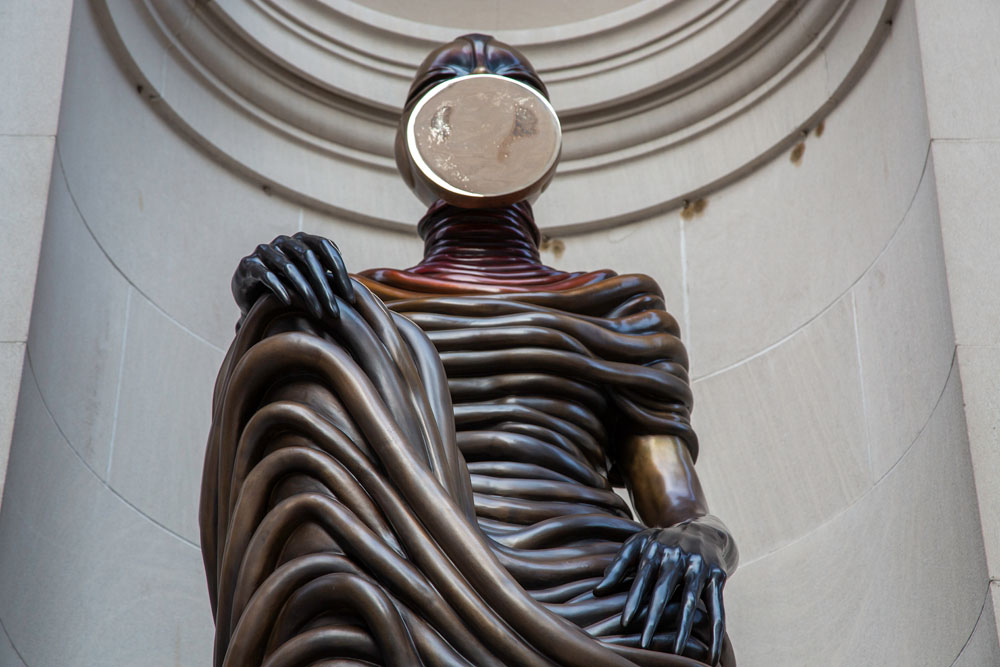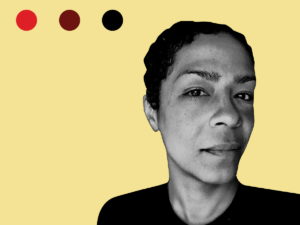
January 15, 2020; Hyperallergic
One of my favorite quotes is popularly attributed to Albert Einstein: “No problem can be solved from the same level of consciousness that created it.” So, I loved reading about three black artists who recently unveiled major art pieces that, as Ulrich Baer writes for Hyperallergic, “productively reframe the divisive debate over historical monuments.”
Baer explains, “While many historians advocate for removing Confederate statues, others warn that removing monuments means censoring history itself.” The compromise to date has been keeping the statues and adding “contextual markers,” or text to be read.
Now three new sculptures commissioned by museums in the US and UK offer alternative visions of history. Wangechi Mutu was born in Kenya and lives in New York. She sees the Met’s invitation to her to create pieces to place in the niches of its facade, as “one of the most proactive moves a museum can make at this particular moment.” She had already been studying caryatids, sculpted female figures that serve as architectural support. In a video describing her process she says,
Caryatids throughout history have carried these buildings to express the might and the wealth of a particular place. In Greek architecture you see these women in beautiful robes. And then in African sculpture across the continent, you see these women either kneeling or sitting; sometimes holding a child, as well as holding up the seat of the king. It felt like this was a very ubiquitous position for women across many, many histories. How do I use this figure to change this conversation and this issue? I wanted to keep the DNA of the woman in an active pose, but I didn’t want her to carry the weight of something or someone else.
Mutu’s four women are cast in bronze and wrapped in coil, showing how form impacts us. She also sees the coils as protection that transform the women into truth soldiers. She turns the round plates that African women adorn themselves with to denote status into mirrors that “take light and flip it around” so that they “flash at you from a distance.” She aptly calls her exhibition The NewOnes, will free us.
She says, “I see these women as characters that have the capacity for freedom and the opportunity to be where they need to be, to say what they have to say. They’re here. They’re present, and they’ve arrived.”
The contribution of portrait painter Kehinde Wiley—Barack Obama’s official portraitist—is “a towering bronze equestrian statue” in Times Square titled Rumors of War. Architectural Digest’s Phoebe Hoban describes it as a “bold and blasting call to arms against the army of Confederate statues that still populate Southern states, particularly [Virginia], which boasts the most.” The statue’s presence in Times Square was a collaboration of Times Square Arts, the Virginia Museum of Fine Arts, and the Sean Kelly Gallery. It was permanently installed at the entrance to the Virginia Museum in December 2019, celebrating the 400-year anniversary of the arrival of the first slaves in America in 1619.
Wiley, a Nigerian-American based in New York City, recalls visiting the Virginia Museum for a retrospective of his work and “looking up at the huge status honoring those dark days.” He told the crowd gathered at the unveiling of his piece that those statues filled him “with dread and fear.” His statue is a rework of Richmond’s statue of General J.E.B. Stuart.
Sign up for our free newsletters
Subscribe to NPQ's newsletters to have our top stories delivered directly to your inbox.
By signing up, you agree to our privacy policy and terms of use, and to receive messages from NPQ and our partners.
Hoban writes, “But instead of a Southern soldier, Wiley’s rider is a young black man, dressed hip hop style, in a hoodie, with earphones around his neck, his head crowned with a short bundle of threads: the contemporary anti-image of a Robert E. Lee.”
Wiley says, “We want more. We demand more…. And today we say yes to something that looks like us. We say yes to inclusivity. We say yes to broader notions of what it means to be an American…. Are we ready?”
The third piece is by New York City-based American artist Kara Walker, who is known for her room-size tableaux of black cut-paper silhouettes. As the Tate describes it, Fons Americanus is a “working fountain inspired by the Victoria Memorial in front of Buckingham Palace.” But, “rather than a celebration of the British Empire, Walker’s fountain explores the interconnected histories of Africa, America and Europe. She explores water as a key theme, referring to the transatlantic slave trade and the ambitions, fates and tragedies of people from these three continents.” Walker calls it “an allegory of the Black Atlantic.”
Baer writes, “It undercuts the celebration of British Empire by showcasing some of the people who paid for its wealth with their freedom, their labor, and their lives.”
Walker describes her work as exploring the power struggles of history, which inform how we see ourselves and others.
Baer concludes, “Instead of debating the accuracy of existing monuments, the artists focus on the imagination’s role in accounting for the past…These works do not present arguments. Rather, they offer glimpses of what José Esteban Muñoz called, after philosopher Ernst Bloch, the ‘anticipatory illumination of art,’ meaning a world which fights injustice and inequality with the unmitigated force of the imagination.”
He observes that these artists use their prominent positions to “acknowledge history has been imagined from an exclusionary point of view from the start.” However, “their point is not to correct history but to alter our point of view” in order to create hope.
Let’s hope this spreads.—Cyndi Suarez












